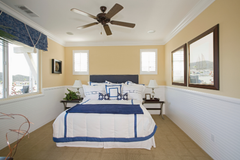
Nautical Style and Coastal Style: What's the Difference?
The Nautical Style
It Was a Fashion First

The Nautical style originates from 19th century England during the reign of Queen Victoria, who dressed her young sons in sailor suits. As it rose in popularity, the style generally referred to white and navy striped apparels that mimicked sailors’ clothing. The striped shirts were also worn by and popularized by celebrities and fashion icons Audrey Hepburn and Coco Channel. As both of these celebrities were known for their timeless fashion, the nautical striped shirt that they adopted eventually became a “classic” wardrobe staple.
As the fashion style grew, it also crept into the realm of interior design.
The Aesthetic

While the fashion can arguably be boiled down to a good white and navy shirt, the interior design style went beyond to encompass all things sailors and sail ships.
Nautical style decor is not shy with metals, and often incorporates a complementary industrial element. It also commonly wears a worn, lived-in look.
- Color Palette: Primary tones; navy and white as a call-back to nautical fashion
- Decor/ Materials: Rope, shiplap walls, anchors, shells, driftwood or weathered wood, burlap, metals
- Complimentary Styles: Industrial
The Coastal Style
The Aesthetic

Unlike the Nautical aesthetics utilitarianism, the Coastal aesthetic is much more relaxed and easy-going. The whole goal of the coastal style is to attempt to convey the feeling of the beach into an indoors living space. As such, the coastal style is a much more abstract theme than that of the nautical style, which directly refers to something tangible.
It is a modern, elegant, but natural style. You may find that the style is flexible too — the coastal style varies around the world to accommodate the local beach environment.
-
Color Palette: light, neutral tones; layers of blues to emulate the incoming
tides on the beach; lots of whites

- Decor/ Materials: natural, breathable fabrics like linen or cotton to evoke the breeze; light-colored woods like driftwood or white-washed woods
- Complimentary Styles: Traditional, Transitional, Mediterranean
